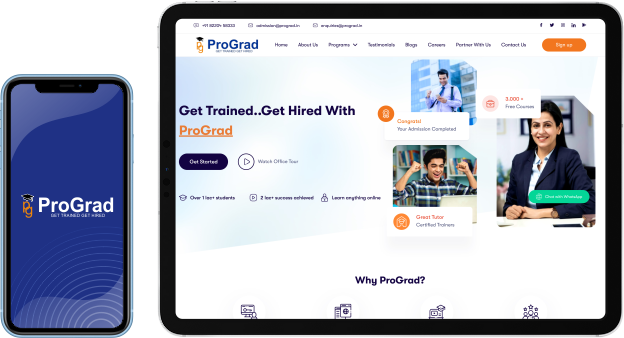Get start your Full Stack Developer carrer with a job guarantee

Join The Best Full Stack Developer Course
The Full Stack Developer Pro course will teach you the subtleties of data structures and algorithms. This job-assured 6-month program will prepare you for a successful career as a full-stack web developer by providing you with the technical knowledge of front-end and back-end programming. With 350 hours of rigorous instruction with a distinguished faculty and 100 hours of doubt-resolution, the program offers the most training hours in the industry.
Placement Guarantee
Get access to 500+ hiring partners and land a job with a minimum salary of 5 LPA or we will refund your fees.
Dedicated Career Services
Our career services include resume development, profile enhancement, interview preparation workshops and one-on-one career counselling to
Job-focused Curriculum
Start by building a strong foundation in data structures and algorithms and learn popular technologies like Java, Spring, MongoDB, JavaScript,
Live Learning
Establish a DSA and full-stack development foundation through online live interactive courses while the teaching assistants will lead hands-on projects and practice sessions.
Hackathon & Coding Challenges
Participate in Coding Hackathons, delivered by our community initiative – Skillenza, to tackle complex business problems and make your resume stand out.
Project Portfolio
Work on multiple projects and build a robust project portfolio to make your resume stand out in front of potential employers.
Leading-Edge Curriculum
Develop a strong foundation in data structures & algorithms (DSA) and learn popular tools like Java, Spring, MongoDB, JavaScript, React, Docker and Jenkins.
What Will You Achieve?
- Strong data structures and algorithms foundation
- Coding skills with 100+ DSA questions
- Competitive programming skills
Topic
- What Is Discrete Mathematics?
- What Is A Set?
- Interval Notation & Common Sets
- What Is A Rational Number?
- Non-Rational Number
- Set Operators
- Overview
of
JIRA
- Walkthrough of the JIRA Interface
- Creating Epic, User Story, Task, Sub-task
- Understanding Various Charts Available
- Our First Repository – Git
- Branching and Merging
- Introducing GitHub (understand local vs/ cloud) Storage
- Creating an Account and Cloning all Codes to GitHub
- Working with PR and Creating Branches
- PostgreSQL
- Introduction to PostgreSQL
- Installing PostgreSQL
- Load Data in Postgres
- Aggregate Function
- Count, Minimum, Maximum, Sum and Average
- How to Insert
- Update and Delete Data from Tables in PostgreSQL
- How to Retrieve Data from tables using Select Queries
- Build Complex SQL Queries to extract important Data from Databases using Table Joins.
- Use SQL Aggregate Functions and Group Data using Group by Clauses
- Working with Complex Aggregate Functions
- Data from Multiple Tables, Having Clause
- Introduction
to
NoSQL
Databases
(MongoDB)
- What is MongoDB?, NoSQL Databases v/s Relational dbs, When
to prefer MongoDB over other NoSQL dbs? - The Current SQL/NoSQL Landscape, Document-oriented vs Other Types of Storage, Mongo's Features, Common Use Cases
- Introduction to JSON
- Documents and Collections - Creating Documents, Managing Documents in Collections,Iterating over Documents
- Simple Queries - Field Equality Tests, Operators Available, Projections, Limiting Results and Paging
- Working with Indexes Creating Index, Simple Index, Compound Index, Hint, Looking at Different Index Types like Text, Sparse, 2D
- Introduction to Core Java Programming and Concepts
- Class and Object Basics
- The Object Model and Object-Oriented Programming, Classes,
- References, and Instantiation, Adding Data to a Class Definition,Adding Methods (Behaviour)
- Package Overview - Using Packages to Organise Code, Import Statements, Creating Packages, Package Statements, Required Directory Structure, Finding Classes
- Packages and Classpath, More on Classes and Objects, Accessing Data, the 'this' Variable, Encapsulation and Access Control,Public and Private Access, Constructors and Initialisation, Static Members of a Class, Scopes, Blocks, References to Objects, Using Lombok for Automated Class Members
- More on Classes and Objects
- Accessing Data, the 'this' Variable, Encapsulation and Access Control, Public and Private Access, Constructors and Initialisation, Static Members of a Class, Scopes, Blocks,References to Objects
- Exceptions and the Exception Hierarchy, Try, Catch and Handling Exceptions, Program Flow with Exceptions
- Creating User-defined Exceptions and Exception Funneling
- Using Interfaces to Define Types, Interfaces and Abstract Classes, Collection: What is Collection? Types of Collection, Need of Collection, List- ArrayList, LinkedList, Contracts between the Hashcode and Equals Method, Set- HashSet, LinkedHashSet, TreeSet {comparable, comparator(using java 8)} Java 8 Features: Functional Interface, Bifunctional Interface
- Predicate, Bipredicate, Consumer, Biconsumer, Supplier Stream: Types of Stream, Stream Methods and Example
- Threads: Reference Types and Threading, Working with Types: Wrapper Classes
- I/O Streams
- Readers and Writers, Filter Streams, Byte Streams
- Formatted Output
- Serialisation Storing and Retrieving from External Files
- Database Access with JDBC
- JDBC Overview, JDBC Architecture, Drivers and Types of Drivers, Driver Manager, Connection Statement, Prepared Statement,Performing CRUD Operations
- Getting
started
with
Hibernate
- Overview of the Hibernate - Hibernate vs. JPA
- Distribution, Configuring Hibernate, Java-based Configuration,Bootstrapping, SessionFactory Configuration, Connection Properties, Database dialect of Configuration Class, Session Interface, Mapping a Class, Primary Keys: Id property, Generated Id, Hibernate Type System, Working with Sessions and Persistent Objects, What is Cache? Types & their Implementations
- The Persistence Lifecycle Transaction Overview and Transactions in Hibernate, The Lifecycle of Managed Objects, Persistent, Transient, and Detached Objects, The Persistence (Session), Context (Lifespan, Relation to Managed Objects, Propagation), Performing CRUD Operations
- Introduction to Spring
- IOC: All Frameworks Use the IoC Principle
- Dependency Injection: Spring Framework Supports
- Using Spring to Configure an Application
- Simplifying Application Configuration
- Annotation-Based Dependency Injection
- Autowiring and Component Scanning
- Component Scanning: How to Do it Right
- XML Versus Annotations: When to Use What
- Life Cycle Annotations: @PostConstruct and @PreDestroy
- Stereotypes and Meta-annotations
- Java-Based Dependency Injection
- @Configuration and @Bean annotations
- Where is the Magic? Inheritance-based Proxies
- Equivalent to XML namespaces: @Enable Annotations
- When to Use Java Configuration
- Bean Life Cycle: How Does Spring Work Internally?
- Spring
Web
- Introduction Spring Web Application - Creating Spring MVC in Web Application
- Spring
Boot
Introduction
-Introduction to Spring Boot, Value Proposition of Spring Boot,
High-level Spring Boot Features, Creating a Simple Boot
Application using Spring Starter - Dependency
Management
using
Spring
Boot
Starters,
How
Auto-
configuration Works, Configuration Properties, Overriding Auto-
configuration, Using CommandLineRunner, - Introduction to MongoRepository, Performing CRUD Operations with MongoDB
- Introduction to JPA & Performing CRUD Operations
- API First Approach, REST design, API Design, Swagger
- Introduction
to
Open
API
Standard,
Versions,
Format,
Document
Structure, Data Types, Rich Text, Relative References in URLs, Schema
- What is Web Service, Types, Why Rest Over Soap?
- How
to
implement
REST
in
Spring
Boot
environment,
@postmapping , @getMapping, @putmapping, @deleteMapping - ResponseEntity,
Returning
Failure
Messages
in
Terms
ofJSONn,
@exceptionalhandler, @controlleradvice - What is spring aop? How it works internally, AOP vs OOP, Joinpoint, Pointcut, Advice
- What is Spring Security?
- What is Authentication & Authorisation?
- Overview of Spring Boot JWT Authentication
- Spring Boot Signup & Login with JWT Authentication Flow
- Spring Boot Server Architecture with Spring Security Technology
- Project Structure
- Setup New Spring Boot Project
- Configure Spring Datasource, JPA, App Properties
- Create the Models
- Implement Repositories
- Configure Spring Security
- Implement UserDetails & UserDetailsService
- Filter the Requests
- Create a JWT Utility class
- Handle Authentication Exception
- Define payloads for Spring RestController
- Create Spring RestAPIs Controllers
- Run & Test
- Introduction to API-Gateway, Hystrix, Eureka and Building the Applications with Netflix Tools
- Hystrix
-Knowing What is Circuit Breaking, Setting up a Micro Service
Application, Apply Circuit Breaker Pattern - Locating Services, Introduction Load Balancing, Knowing
- Failover of Middle-tier, ELK Stack, Kafka topics
- Docker
-Introduction to Docker, Docker Architecture, The Docker Hub,
Docker Installation, Creating Our First Image, Working with
Multiple Images, Containers, Packaging a Customised Container,Running Container Commands with Docker - Exposing Our Container with Port Redirects
- Seeding Container to hub.docker.com
- Accessing Public Containers Created
- Creating Network in Docker
- Calling One Container from Other and Test
- Prune Containers
- Introduction to Kubernetees
- What
is
Container
Orchestration,
Setting
Up
K8s,
Working
with
Miniube, Installing k8s using Docker Client, Understanding -
Node Architecture, Deployments, Services, Labels, Health checks, Pod, etc. - Deploying Spring Boot Application with K8s
- Introduction to CI/CD, Installing Jenkins, Setting Up Dependency Management
- Containerising
and
Deploying
a
Spring
Boot
Application
with
Jenkins
(Source Code from SCM, Containerisation with Docker, Deploy on Local System)
What Will You Achieve?
- Learn JavaScript to build exciting UI
- Develop complex and efficient UIs with React
- Integrate front-end and back-end skills to create a complete application
Topic
- Introduction To Web Development
- How Web Applications Work
- An introduction to HTML and CSS
- Tools for Web Development
- How to View Deployed Web Pages
- Five Critical Web Development Issues
- The
HTML
syntax,
Images,
Basic
Skills
for
Working
with
Images
Advanced Skills for Working with Images - Related
Skills
for
Working
with
Images,
Forms,
How
to
Use
Forms and Controls, Other Skills for Working with Forms - How to Use the HTML5 Features for Data Validation, How to Use the HTML5 Controls
- A Web Page that Uses HTML5 Data Validation
- Using CSS to Format the Elements of a Web Page
- An introduction to CSS
- Measurements and Colours, Selectors, Cascading Style Sheets
- How to Work with Text
- A Web Page that Uses External Style Sheets
- Introduction to Media Queries
- Creating applications with Mobile-first Approach
- Difference between Desktop-first vs. Mobile-first
- Creating Your First Web Page with Bootstrap
- Including
Bootstrap's
Files
via
CDN,
Bootstrap
Grid
System,
Creating Fixed, Fluid Layout with Bootstrap - What is Responsive Web Design or Layout?
- Bootstrap Typography, Tables, Lists, Forms, Input Groups, Buttons, Images, NavBar etc
- Creating a form using Bootstrap
- Creating a Static Site with Bootstrap
- Introduction
to
JavaScript
Language,
Using
Script
Tag,
Inserting
Java Script into Tags, Linking Java Script from Separate Files,
JavaScript Expression and Operators, Defining and Naming
Variables, Data Types, Expression, Returning Values from Functions
Function: Advanced Concepts - Function
as
Data,
Anonymous
Function,
Callbacks,
Self-invoking
Function, Inner (Private) Functions, Functions that Return Functions - Function: Rewriting itself, Variable Scopes, Function Level, No Block Level, Global Level
- What
Are
Objects?
Objects and the Dot Syntax, Creating an Object with a Constructor,
Properties of the Object, Methods of the Object - Introduction to ES6 Features
- jQuery
Introduction
- Install and Use jQuery Library
- Un-Obstructive JavaScript
- First jQuery Example
- jQuery Syntax
- Basic Selectors, Filters
- ReactJS
Fundamentals
-Introduction to ReactJS, React and SPA - The
Create-react-app
CLI,
Project
Structure,
React
Introduction,View
Technology
-React and SPA, The Create-react-app CLI, Project Structure,
Understanding What React Is, What Problem React Solves - First
React
Project,
Code
Formatter
Setup,
Building
Static
Site
Using React, JSX, Introduction, States and Properties, Stateless
Components, Stateful Components, Styling Approach in React
Component Lifecycle Events, Event Categories, Event Definition,
Mounting and Unmounting Events, Components and Props, State
and Lifecycle, Handling Events - useState, useEffect, useRef
- Working with Hooks Example
- Fetching Endpoint with Hook
- Working with Lazy Initialisation with Hooks
- Introduction to useContext
- Redux
for
State
Management,
Introduction
to
Redux,
Basic
Building Blocks, Store, Actions, Action Types and Action Creators,
Dispatch Mechanism, Vanilla Redux for Better Understanding,
Redux with ReactJS, The Application Flow, Choosing the Right
Model for Store, Implementing Redux for a Basic Application - Introduction to React Router
- Route Configuration – Link, Navigate, Route, Router
- Creating
AWS
Account,
Understanding
ec2
Instance
- Deploying Spring boot Application with Containerisation - Introduction
to
Amazon
Simple
Storage
Service
(S3)
- S3 Regions, Buckets and Objects - Create
Bucket
in
S3,
Upload
-
Make
Public
-
Rename
-
Delete
File
in S3, Delete and Restore Files in S3 - Testing : JUNIT, JEST
What Will You Achieve?
- Learn to plan a full stack development projec
- Develop an end-to-end full-stack application
- Gain confidence in your skills by presenting the project to industry experts
Topic
What Will You Achieve?
- Combination of all skills learned throughout the course
- Project presentation skills
What Will You Achieve?
- Build an exciting resume and digital profile for recruiters
- Sharpen interview skills with mock interview sessions
- Resolve any career-related queries have clarity and confidence
Topic
- Resume-building
- GitHub Profile
- Mock Interviews
- Career Mentorship
Learners’ profiles
Basic knowledge of at least 1 programming language is mandatory for admission.
Students
Final year students from STEM background (preferably CS, IT, Electronics) with min 50% marks
Marks
Fresh graduates/Postgraduates in STEM (preferably CS, IT, Electronics) with min 50% marks
Experience
Experienced Professionals (0 to 3 years)
Instructor

Danesh
ProGrad Achiever
Many thanks to prograd for having my dreams come true. I feel blessed and thankful to all faculty members and also every person herein shaping my profession in banking. I can say with absolute certainty that as a result of everything I mentioned above. I have been able to reinvent myself into a more confident and consistent individual.

Jayesh
ProGrad Achiever
During the course I learned numerous things about banking and its allied sector. Prograd gave me good opportunity to attend interviews to build our career. I have learnt how to communicate with people and rectify my mistakes. Today I am happy working with leading bank.
Get the Certificate?
Upon successfully completing this program, you’ll earn a Full Stack Developer Pro certificate.
Industry-Specific Projects
Who can Join this Course?
Candidates with the following prerequisites can apply for Full Stack Development certification courses:

















